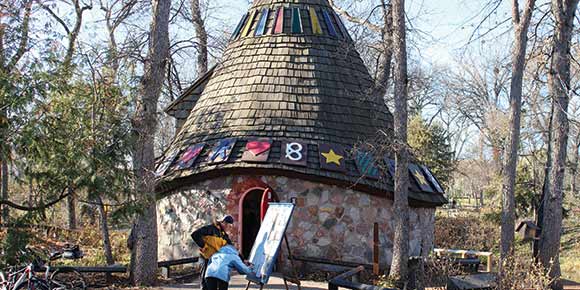As we discovered in part one of the history of Kildonan Park in the December 14 issue of the Real Estate News, uncertainty about its future and funding cuts during the war and the Depression meant that the park never lived up to the grand vision set out in George Champion’s original master plan. Many of its built amenities were temporary or, like the pavilion, ended up a fraction of their intended size.
In the 1950s, the parks board took a renewed interest in Kildonan Park and began a slow renewal process that led to the construction of many unique facilities that continue to serve visitors to this day. These are just three examples of that new development.
Peguis Pavilion (1965)
The Peguis Pavilion replaced the original Kildonan Park pavilion constructed in 1915.
It was designed by Morley Blankstein and his firm Green Blankstein Russell, (now called Number Ten Architectural Group), which was at the forefront of modernist architecture in Winnipeg. Other GBR projects at the time, such as Winnipeg City Hall and the Winnipeg International Airport, earned them national accolades.
Construction began on the $165,000, two-storey building in the summer of 1964. The upper level provided the park with a full-service restaurant and lounge as well as an expanded concession stand. Its north wall is mostly glass and wrapped by an open-air balcony. The lower level features washrooms, a change area and indoor seating.
Lord Selkirk Creek was dammed to create the duck pond to the north of the building which is used as a skating rink in winter. In January 2019, a new lighting installation by artist Takashi Iwasaki called Bokeh was unveiled over the water.
The pavilion is named for Chief Peguis, whose bust can be found on the pavilion grounds. The sculpture, however, was there long before the building.
It was commissioned by the Lord Selkirk Association of Rupert’s Land in 1923 and is dedicated: “In memory of Peguis, Chief of the Salteaux Indians and in grateful recognition of good offices to the early settlers.” The artist was Paris-born and trained Marguerite Taylor whose work includes the Soldiers’ Relative’s Monument on the Legislature grounds.
Peguis was unveiled on Victoria Day 1924. Attendees at the ceremony included Lieutenant Governor Sir James Aikins and W. H. Prince, a grandson of Peguis.
Another sculpture on the grounds is a totem that was carved by James F. Sutherland of Vogar, Manitoba and unveiled in July 1970.
Rainbow Stage (1954)
Music has been a big part of Kildonan Park’s history. This was most evident during the height of the Depression when the Winnipeg Tribune hosted a series of “Community Song Nights” to help people escape the misery of daily life. One evening in August 1932 around 20,000 people jammed the park and were led in song by an orchestra and community choir from the bandshell.
That bandshell was destroyed by the Red River Flood of 1950 and two years later the campaign to build a new one began. The city’s parks board wanted something more permanent and on a grander scale so that more elaborate shows could be held there. They challenged the public to match their $15,000 contribution towards its construction.
Architects Smith, Munn, Carter, Katelnikoff were hired to design the new facility. It ended up being called “Rainbow Stage” because of its arched proscenium.
Construction got underway in September 1952 and the new facility, which ended up costing closer to $50,000, officially opened on July 7, 1954. Opening night featured a variety show of comedy, dance and music that included performances by the CBC Orchestra and Lowe’s Accordion Band.
In all, nineteen different events took place at the theatre that first summer.
The site has undergone numerous expansions and improvements over the decades. In 1957, its seating capacity was expanded to nearly 3,000. To allow performances to take place in the rain, a fabric-clad, aluminum-framed, triodetic dome was installed overhead in 1970. The fabric was replaced by plastic panels in 1977.
The administration of the theatre was transferred from the parks board to the Winnipeg Summer Theatre Association in 1956. A decade later, the non-profit organization Rainbow Stage Inc. was created.
With a seating capacity of 2,600, Rainbow Stage is the country’s largest and longest-running outdoor theatre.
Fairy Tale Cottage (1970)
Known to most as the “Witch’s Hut”, this unique structure is officially called Fairy Tale Cottage, or Maerchenhaus, and was a Canadian centennial project of the German-Canadian community dedicated to the children of Manitoba.
The German-Canadian Centennial Committee met in November 1966 to finalize plans for the building and to begin fundraising the $20,000 needed from German-Canadian organizations across the province. They even received some donations from other parts of Canada and Germany.
Winnipeg architect Hans-Peter Langes designed the building which replicates the witch’s hut described in the Grimms’ fairy tale Hansel and Gretel.
The man who did much of the construction was stonemason John Neilson, originally from Sweden. He sourced the granite stones for the walls from West Hawk Lake, chose the logs that made up the roof structure and forged most of the hinges and door handles.
The building’s exterior, which measures approximately 7.6 metres in diameter and 7.3 metres in height, was completed in October 1968. It took nearly two years to finish the interior which includes a frieze depicting the story of Hansel and Gretel and a circular staircase that leads to the witch’s lair.
Fairy Tale Cottage was officially opened on October 24, 1970.
Christian writes about local history on his blog, West End Dumplings.



